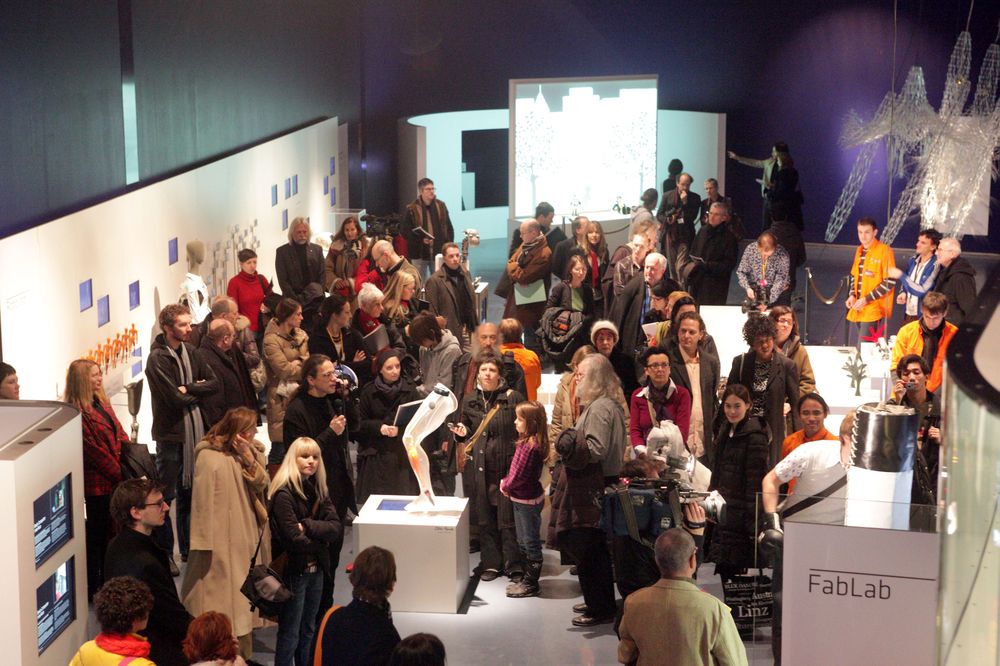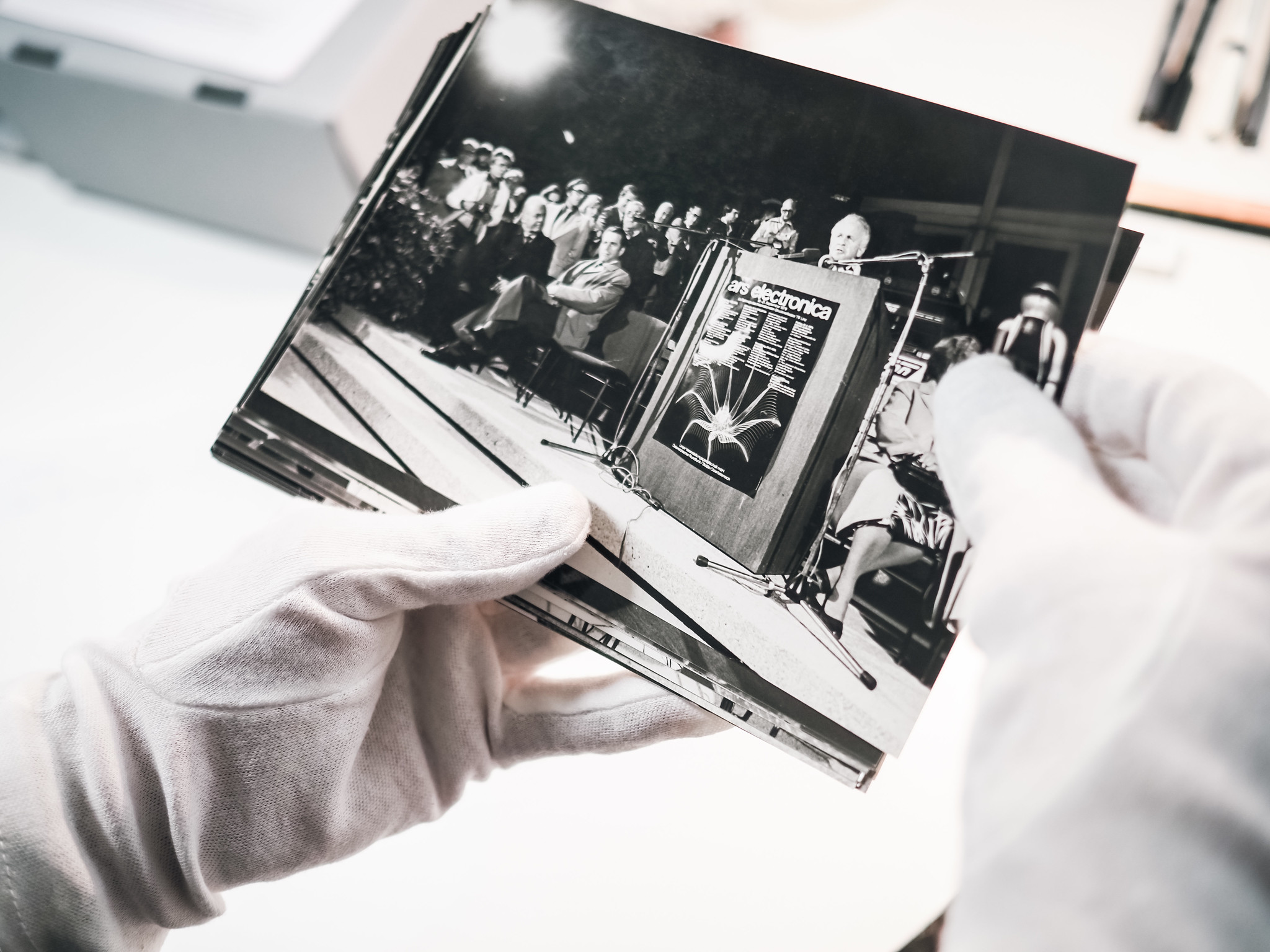What do an archive of media art and the history of AI have in common? And can these histories perhaps be intertwined in order to gain a better insight into what has fascinated and preoccupied people at different times with the idea of “artificial intelligence”?
The history of artificial intelligence (AI) is a fascinating journey from early speculation and mythical ideas to the sophisticated technologies that shape our everyday lives today. The Ars Electronica Archive offers a unique insight into this development by documenting the intertwining of art, technology and society:
Ars Electronica has one of the world’s most extensive archives of digital media art, which has been continuously expanded since 1979. The collection includes artistic works, project documentation, exhibitions and activities that document the development of international media art over more than four decades. These include, in particular, the Ars Electronica Festival, the Prix Ars Electronica and the Ars Electronica Futurelab. Now, after 45 years, this archive has been comprehensively revised under the title “Ars Electronica Archive Relaunch” as part of a large-scale EU project funded by the Federal Ministry for Arts, Culture, the Civil Service and Sport. The aim of this initiative is to make the archive accessible to a wider public and to bundle the resources in the national cultural pool and on the European platform Europeana.
Software updates and the adaptation of the data model will ensure the continued existence of the extensive treasure trove of data. New linking options will simplify the storage and management of data. A redesigned user interface will allow employees in all areas to use the archive more actively, while data cleansing in the area of personal data will enable better networking both within the archive and with other archives. Particular attention is being paid to harmonization with international data standards in order to ensure compatibility with other data sources. The European archive platform Europeana, on which the data is also made available, plays a central role here.

A second important project strand expands the archive to include the legacy of Hannes Leopoldseder (+2021), one of the main protagonists of Ars Electronica, especially in the early years up to the mid-1990s. This expansion significantly increases the number of digitized historical documents and places a special focus on the origins of the festival, the Prix Ars Electronica and the museum. This represents an important contribution to accessibility and historical documentation in the field of media art.
The results and findings of this project will be published on the Ars Electronica website upon completion. A selection of the newly digitized documents will be accessible in the AE Online Archive and on the European platform Europeana. The Archive Relaunch project underscores Ars Electronica’s role as a leading institution in the preservation of Europe’s digital cultural heritage.
As an example of this very preservation of European digital cultural heritage, in this blog post we explore how the social perception and discourse on AI has changed over the years – illustrated by significant milestones of the Ars Electronica Festival as well as the Ars Electronica Center, compiled from the Ars Electronica Archive.
Early ideas and artistic speculation
The idea of artificial, human-like creatures goes far back into antiquity. Myths and legends such as the mechanical servants of Hephaestus and the Golem in Jewish tales reflect early speculation about artificial life. While these ideas remained speculative and mythological, they laid the foundation for later thinking about artificial intelligence.
In the 17th and 18th centuries, mechanical automata such as Jacques de Vaucanson’s writing automata and the Shaft Turk, a famous vertiginous automaton, inspired the idea that machines could mimic human abilities. These early developments in mechanics led to increasing fascination and speculation about the possibilities of machine intelligence.
These ideas are also reflected in the AIxMusic exhibition at the Ars Electronica Center: from the first stringed and wind instruments of antiquity to the digital synthesizers of our time, from the wax cylinders and soot-covered glass plates of the first precursors of the gramophone to the digital streaming services of the Internet, composers and musicians have always been pioneers of the technological possibilities of their time. Now, in modern times, machine learning and artificial intelligence are once again opening up many new possibilities for creative design that artists around the world are already exploring.
The beginning of modern AI
Alan Turing’s 1950 essay “Computing Machinery and Intelligence” marked a turning point in the discussion about machine thinking. Turing asked the famous question “Can machines think?” and proposed the Turing test to assess a machine’s ability to exhibit human-like behavior. These ideas formed the basis for the later development of AI research.
„The Turing Game“ takes up this very question and combines it with the latest research findings to make it accessible to visitors to the Ars Electronica Festival 2024 as a game. The installation was developed at the LIT Linz Institute of Technology by an interdisciplinary team of researchers and will be shown at the JKU MEDCampus as part of the festival.
Back to the past: the 1956 Dartmouth Conference, organized by John McCarthy, is considered the birth of AI research. It was here that the term “artificial intelligence” was coined and a new discipline was born. Participants such as Marvin Minsky and Herbert A. Simon laid the foundations for the development of AI algorithms and systems.
Marvin Minsky was to be a guest at the Ars Electronica Festival years later, in 1990 and 2004, but more on that later.
AI in the 1960s and 1970s: First steps
In the 1960s, the first AI programs were created, such as ELIZA by Joseph Weizenbaum, which simulated simple human conversations, and Shakey, the first mobile robot. These early systems were limited, but laid important foundations for future developments in the field of machine learning and knowledge representation.
The social relevance of these developments was reflected in artistic speculation and media representations. Films and literary works began to address the possibilities and dangers of AI, which led to a broader public discussion.
This period also saw the birth of Ars Electronica in 1979, which began and continues to operate under the following credo: We see digitalization not as a technological development, but as a social one.
The era of expert systems: 1980s
In the 1980s, the focus shifted to expert systems, which were used in specialized application areas such as medical diagnosis and financial advice. These systems used rule-based approaches to represent knowledge and make decisions. A well-known example is MYCIN, an expert system for the diagnosis of bacterial infections.

In 1986, the Ars Electronica Festival presented the exhibition “Terminal Kunst”, which included an “Artificial Intelligence” laboratory. Jürgen Claus’ (+2023) work “Künstliche Intelligenz – Flüssiges Denken (aus dem Bildtagebuch)” addressed the fluid nature of thinking and the possibilities of artificial systems to imitate human thinking. Even then, this shows how art and technology inspired each other and shaped the discourse on AI.

Social discourse and cultural representations
Films such as “2001: A Space Odyssey” (1968) and “Westworld” (1973) also brought the topic of AI into popular culture and aroused interest and speculation. These works reflected society’s fascination and fears about the possibility of machines that could exhibit human-like behavior and possibly even develop consciousness.

The 1990 Ars Electronica Festival, whose theme was “Digital Dreams – Virtual Worlds”, reflected these social and cultural developments. Marvin Minsky, a pioneer of AI research and already mentioned at the beginning, gave a lecture in the panel “Digital Dreams – Virtual Worlds”. This event highlighted the growing relevance of AI in both scientific and artistic circles.

The 1990s: the breakthrough of machine learning
With the increase in computing power and the availability of large amounts of data, machine learning became increasingly important in the 1990s. Neural networks and other techniques were further developed, and the victory of IBM’s Deep Blue over world chess champion Garry Kasparov in 1997 was a milestone in AI development. This victory put AI in the headlines and aroused widespread public interest.

The 1993 Ars Electronica Festival focused on “GENETIC ART – ARTIFICIAL LIFE” and reflected the interface between genetics and AI. Projects such as Peter Kogler’s “Ants” symbolized the comparison between computers and natural systems such as anthills. This metaphor illustrated how AI systems can imitate collective behaviour and self-organization, similar to what can be observed in nature.

Intelligent environments and interactive art
In 1994, the Ars Electronica Festival set new accents with the theme “INTELLIGENTE AMBIENTE – INTELLIGENT ENVIRONMENT”. Projects such as “Piazza Virtuale” by Van Gogh TV enabled participants to interact as avatars in virtual spaces. These projects showed how AI and virtual reality can enable new forms of social interaction and communication.

Another milestone was the year 2000, when RoboCup received a special jury prize in the Interactive Art category. This competition for autonomous robots highlighted the advances in robotics and AI and showed how these technologies can be used in interactive and playful contexts. The RoboCup helped to raise and promote public interest in AI and robotics.

AI in the 21st century: Deep neural networks and everyday applications
With the rise of deep learning and neural networks in the 2010s, these techniques revolutionized many areas of AI application. Voice assistants such as Siri, Google Assistant and Alexa became popular, and autonomous vehicles came within reach. AI-based translation systems such as Google Translate improved significantly and became everyday tools.

This was also the time of Marvin Minsky’s second visit to Ars Electronica 2004: he spoke at the festival on the subject of “Timeshift – The World in 25 Years” at the theme symposium, the whole lecture can be found here.

Meanwhile, the Ars Electronica Center celebrated its grand reopening in 2009 on the occasion of the Cultural Capital Linz ’09: The new Ars Electronica Center offers 3000 square meters for exhibitions, 400 for seminars and conferences, 650 square meters of catering and event space and 1000 square meters of space for the laboratories and workshops of the Ars Electronica Futurelab as well as 1000 square meters of forecourt for open-air events.
In the exhibition area, the focus is on people – there is no mention of artificial intelligence for the time being, even if the technology always resonates – “New images of people” is the motto. The new exhibition offers an exciting tour through the worlds of thought and images of modern life sciences. The focus is on interaction, do-it-yourself and the joy of discovery.

Finally, in 2019, the “Understanding AI” exhibition at the Ars Electronica Center once again focused on the topic of artificial intelligence. Installations such as “What A Ghost Dreams Of” by Hideaki Ogawa and “SEER: Simulative Emotional Expression Robot” by Takayuki Todo showed visitors interacting with intelligent systems. These exhibitions made it clear how profoundly AI has influenced and will continue to influence our lives and culture and stimulated a discussion among the audience about precisely this.

Ars Electronica Archive as contemporary witness and storyteller
The history of artificial intelligence is closely intertwined with artistic and technological developments. The Ars Electronica Archive documents this development and offers a fascinating insight into the growing role of AI in our society. From early speculations to mechanical automata to modern technologies, the archive shows how profoundly AI influences our lives and shapes social discourse. It is a testament to the ongoing development and continued relevance of artificial intelligence in the public consciousness.

The ongoing exploration of AI, both within the Ars Electronica Festival and in the Center’s exhibitions and all other areas of Ars Electronica, demonstrates how art and science come together to open up new perspectives and promote social reflection on technological advances. By documenting these developments, the archive contributes to understanding the history of artificial intelligence in a broader cultural and social context.
The “Archive Relaunch” project is funded by the Federal Ministry of Arts, Culture, the Civil Service and Sport.
